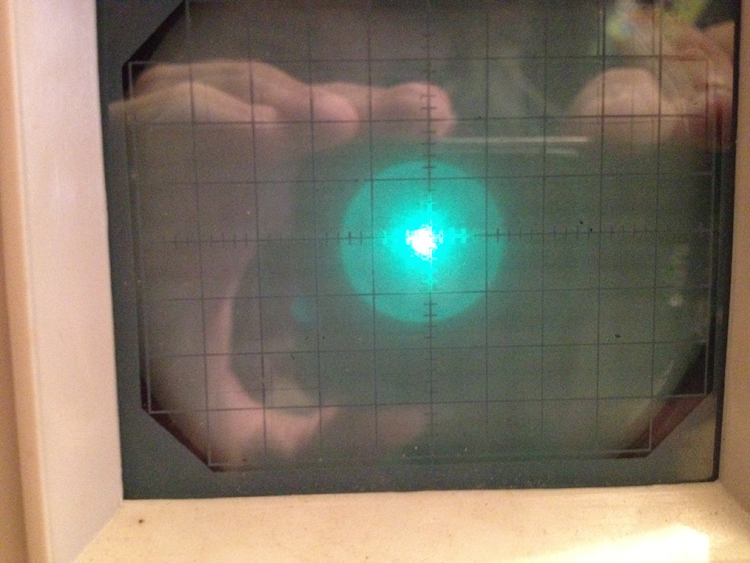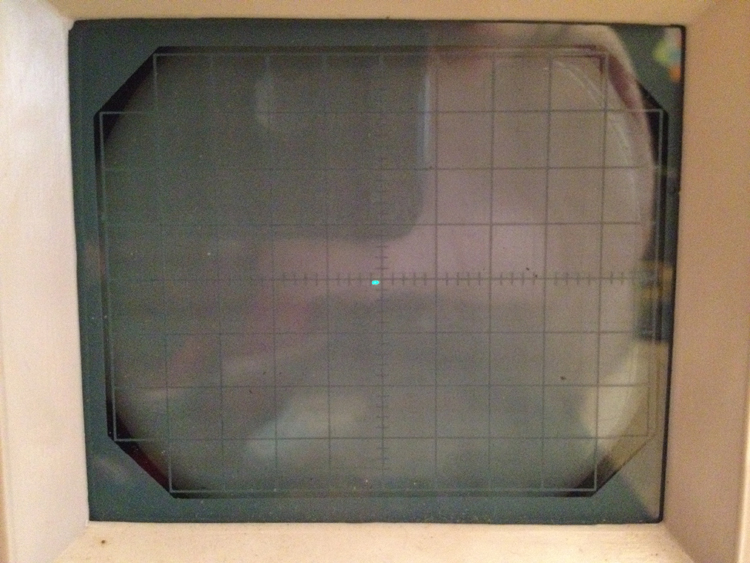An Oscilloscope is a very useful piece of test equipment to have if you are working on electronic circuits or equipment. It can be used to find problems or check that everything is working correctly. For example, making sure the filtering in a DC power supply is filtering the output correctly or checking the output of a logic controller among other things.
So lets take a look at an oscilloscope. You will find the controls are generally the same on all “scopes” but they may differ if they are a single or dual channel scope. The one below is a single channel scope which means you can only measure one point of a circuit at any one time. They come in either CRT or LCD display models, CRT based scopes are generally cheaper although the newer digital LCD based scopes allow you to record and save info displayed on screen.

You have two main controls, these are the volts per division and time per division. Time on the X axis of the screen and voltage on the Y axis. On the screen there is a grid pattern, each square is one division. Generally most scopes are adjustable between 5 volts/div down to a few mV/div. Range of time/div is dependant on the frequency range of the scope, most cheap scopes only going up to 10-20 MHz max although more expensive ones will measure up to a few GHz or more.


Below the time and voltage controls are the trace position controls. The trace is the line going across the screen and can be moved up and down, left and right. Also there are the calibration controls (var) and the level control.

Below this is the AC/DC select button and Ground button (the inverted T)along with the Trigger controls and X/Y select button. The trigger can be left on auto as you won’t usually use it unless there is a need for it dependant on the circuit under test. The X/Y control allows you to connect a signal to the X/Y plates in the tube for instance by feeding two sine waves 180 degrees out of phase onto the X and Y inputs you will see a perfect circle appear on screen. Be very aware that you don’t leave the scope set to X/Y with no input as the resulting dot you will see on screen will permanently damage the phosphor on the CRT screen if left for length of time. LCD models obviously won’t have this issue. You can use this setting to centre the trace on the X axis but only do it with the brightness set low enough that you can just see the dot so the phosphor isn’t damaged while you make the adjustment. Just don’t leave the dot on one point of the screen for a long period of time.
This will damage the phosphor very quickly.

If you use the X/Y setting to centre the traces, set the brightness low like this.

To the left of the display are the brightness and focus controls. The calibration output is a brass tab below these controls providing a 1 KHz square wave at 0.5 volts peak to peak. This is standard on all oscilloscopes. To calibrate the scope, take your probe and clip it to this tab leaving the ground lead disconnected. Set the volts/div to .5v/div and time/div to 1ms/div, adjust level control until you see a square wave on screen. Hit the ground button which is labelled “ground” or has a ground symbol on it, the square wave should disappear. Centre the trace on the centre line of the screen using the position controls and then hit the ground button again, the wave should reappear on screen. Adjust the Y axis so the top and bottom of the wave are half a division from the centre line. Adjust the X axis so the top right of the first peak and the second peak are one division apart. Disconnect the probe and you are done, your scope is now calibrated. I would suggest checking the calibration each time you use the scope just in case it has changed slightly.


You should see something like this when calibrating the scope

The Probe
As you can see below we have a typical oscilloscope probe.

On the end is a hook which if you pull the plastic end back, exposes it. This plastic hook end is generally detachable by simply sliding it off the end of the probe. The black lead is the ground clip which you connect generally to the ground point of the circuit. It is bonded to the scope ground and the grounding pin of the mains power cord. Be aware that if the circuit under test is mains powered or even connected by USB to a PC like an Arduino for instance, connecting the ground lead across the wrong point could create a short circuit damaging the circuit under test, the scope or your self. With a dual channel scope, connect the ground leads of the two probes to the same point in the circuit for the same reason. You can connect them to different points if you use a differential amplifier with the scope which is designed with this in mind. Never remove the ground pin from the mains lead as the scope needs this connection to operate correctly.


On the probe is generally a switch which in this case is marked X1-X10. This is an attenuator probe, what this means is that say for instance you want to measure a 50 volt AC supply. The scope only goes up to 5v/div so 20 volts max. What you do is flick that switch from X1 to X10, now each 5 volt division is 50 volts. It lowers the volts/div by a factor of 10 allowing the measurement of high voltages using the scope. You can get different probes with differing attenuating values.
 http://totseans.com/wp-content/uploads/2012/08/IMG_0648.jpg
http://totseans.com/wp-content/uploads/2012/08/IMG_0648.jpg
The oscilloscope is a pretty handy piece of equipment and once you learn the basics, very easy to use particularly the CRT models at the expense of some modes and the ability to pause and analyse events. A single channel, 10 MHz CRT scope will set you back around $150 – 200 at the most and will be more than enough to do basic testing.
Written by Dakologist

